Ticks! TIIIIIIIIIICKS!
Written by Jonathan Wojcik
As a life long lover of nature's boundless diversity, someone who finds every hair on the head of an Anopheles mosquito as heartwarming as every whisker on a fat, clumsy kitten and someone with open contempt for the prevalence of Arachnophobia, it may come as a surprise to many that I sort of have one zoological phobia myself. One so severe during my childhood that I feared even setting foot in the lush wild environments I so badly wanted to play in. One that triggered such a blind, hysterical flight response that I'm lucky it was never triggered on the edge of a busy highway.

What was it about ticks, and only ticks, that ever turned me into such a big baby? Enough fear persists that they're still constantly on my mind when I'm outdoors, and just thinking about them in depth leaves me with the pitter patter of imaginary feet tip-toeing their way through my hair. I suppose, then, that I am familiar with the sensations experienced by people with a knee-jerk fear of insects and arachnids, but there is one important difference here, and yes, this is the precise criteria by which I separate people who are merely "afraid" of something from the jerkholes:

"It's otay! I'm only wittle!"
No matter how unreasonably scared I've ever been of these eight-legged Nosferatu, I don't dislike them on a personal level. My psychological glitches aren't their fault. There isn't any malice or cruelty in their simple, natural quest for survival. I don't wish they were gone. I don't even wish they were different. I would rather a world with giant, blood-sucking mites who have given me panic attacks than a world where they never evolved at all. Like every other organism that ever has and ever could possibly exist, ticks add something unique, exotic and interesting to our planet that I feel only the utmost respect and admiration towards, even if they leave me in mortal fear of entering tall grass.
They're just not the kind of pocket monster you really want to catch.
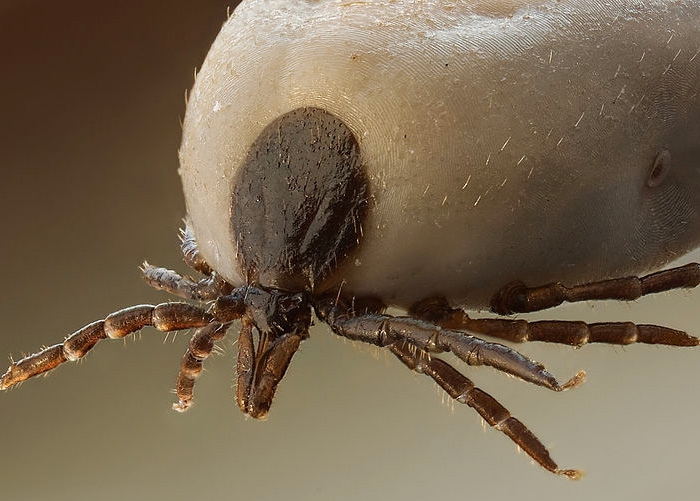
It isn't a tick's diet that ever distressed me, nor even the substantial threat of disease, since I have little fear of fleas, mosquitoes, horseflies, bedbugs or leeches. What I've always feared, and in fact successfully avoided for my entire life, is the whole prolonged epidermal embedment aspect. I have always been a colossal weiner about needles, thorns, broken glass particles or any other foreign object lodging itself unexpectedly under my precious surfaces, and ticks are in many ways like sophisticated, mobile, body-seeking splinters. While many ectoparasitic arthropods are content to dine and dash, a tick may remain attached to its host for days, bloating from a flattened, armored eight-legged sesame seed to a taught, rubbery eight-legged grape. The fun part, of course, is how they get themselves there in the first place.

Your typical "hard" tick (I'll explain this later) begins its life as one of several thousand delicious looking eggs laid by a single proud mama, who promptly expires. Seriously, though, that looks like nothing but my favorite salty-sweet, sushi-grade fish roe. I bet it pops between your teeth the same way. These eggs are also very sticky, and deposited in clumps on low-lying foliage where warm blooded hosts are most likely to pick them up.

Barely visible to the naked eye, a freshly hatched ticklet is nearly transparent, sexless, and awkwardly clambers about on six legs, but this is no insect. Ticks are Arachnids, just like spiders, scorpions and a host of other weirdos, including their fellow Acarina, or mites. Ticks are in fact the largest mites known to man, which doesn't say much from our perspective, but to the mites in your eyelashes and bedsheets, a tick is a colossus. Only after its first taste of blood will this larval behemite undergo a molt to acquire its fourth set of legs, entering the nymph stage.
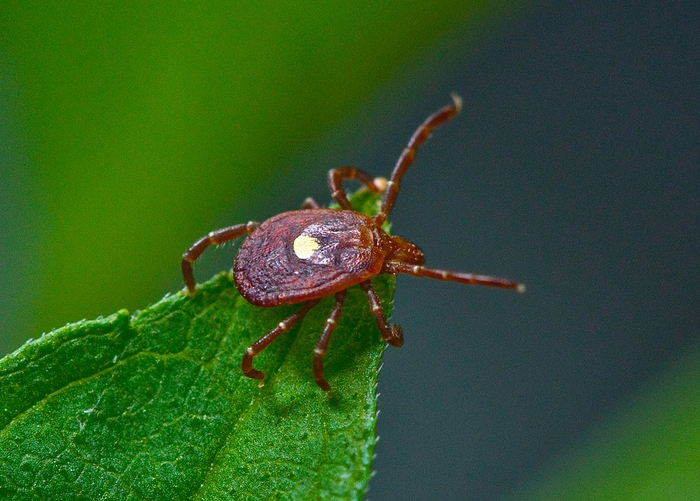
Some hard ticks spend their entire lives on the same single host, while others may be "two host" or "three host" ticks. Between each meal, a multi-host tick will drop to the ground, find a safe place to molt and then begin "questing" for its next victim. Able to survive many months without food, a questing tick can simply perch on the tip of a blade of grass, hold out its arms and wait patiently for a food-filled, hairy giant to brush by - an animal equivalent to the sticky, prickly hitch-hiking burrs produced by more pugnacious plant life.
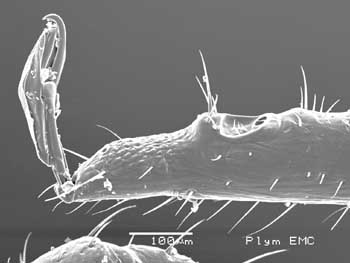
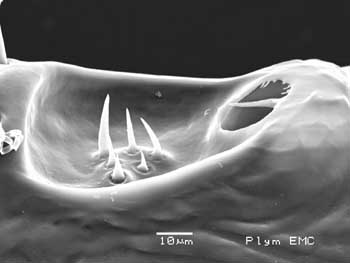
Aiding in a tick's hunt are the Haller's organs, unbelievably tiny sensory pits unique to a tick's forelegs. These function basically as a set of tiny "noses," sensitive enough to "smell" the heat, humidity and especially the carbon dioxide emitted by us blood-havers.
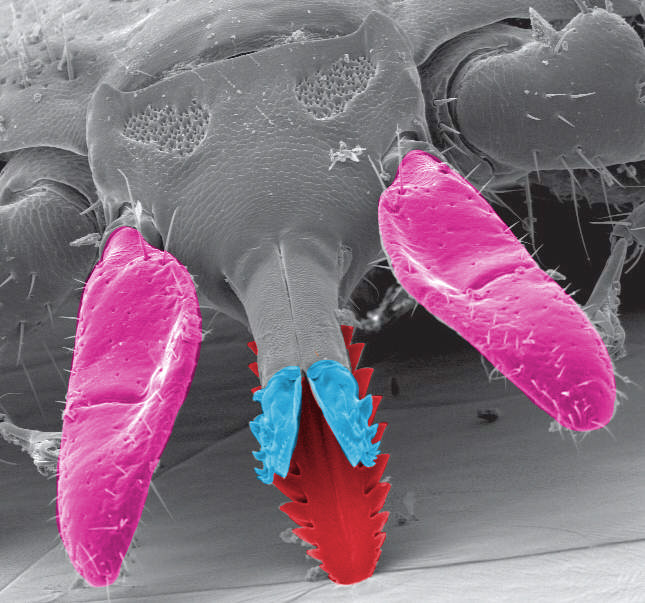
At last finding itself on a planet of walking meat, the tick uses its paddle-like palps (pink) to gently pinch the skin surface into an itsy-bitsy little tent, snips the end open with its chelicerae (blue) and ease its heavily barbed, flexible hypostome (red) into the nearest vessel. As it slides this toothed rod deep into the makeshift orifice, it salivates a protein concoction which rapidly hardens, like a natural glue, to seal off the wound and anchor itself even tighter in its host. We also get a nice look at the porosal areas here, a set of porous patches found mainly in females, the purposes of which are vaguely understood.
As the tick drinks, it filters out excess, nutritionless moisture and regurgitates it back into the host's blood stream, which would seem like a courteous gesture if this wasn't the mechanism various infectious microbes have learned to use to their advantage. We're not here to talk about diseases, but here's a handy list of just a few things the little scamps might puke into your veins, and here's a handy article on various ways people have kept ticks off themselves and their dogs!
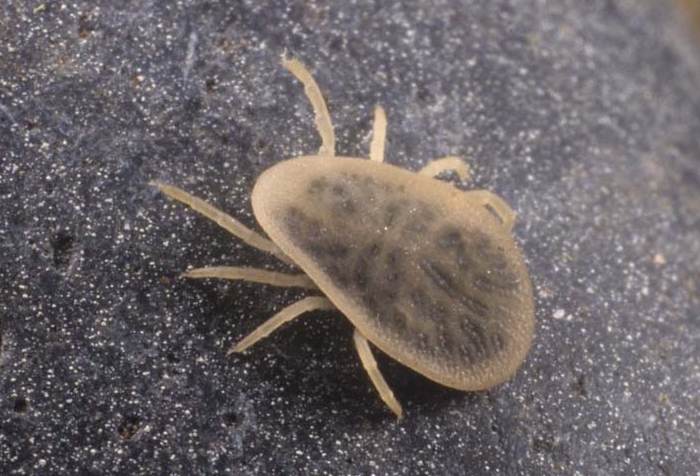
I've said "hard tick" a couple of times now, and that's because the ticks most people are familiar with are of the "hard" variety, family Ixodida. Their sisters the Argasidae are the "soft" ticks, often distinguished by a charmingly "headless" appearance. With some exceptions, softies tend to carry their mouth parts farther under the rim of their dish-like bodies, as squishy and leathery as their names imply. So, why these differences?
The protruding mouthparts and rock-hard armor of a hard tick are well suited to its preferred feeding method, allowing it to anchor deep and binge all weekend while the host tries and fails to dislodge its toughly shielded body. Soft ticks, on the other hand, follow a more bedbug-like pattern, coming out of hiding while their hosts are asleep to feed for only seconds at a time. Preferring birds and bats as hosts, these mushier cuddlebugs are seldom encountered by mankind outside the scientific and poultry-rearing communities.
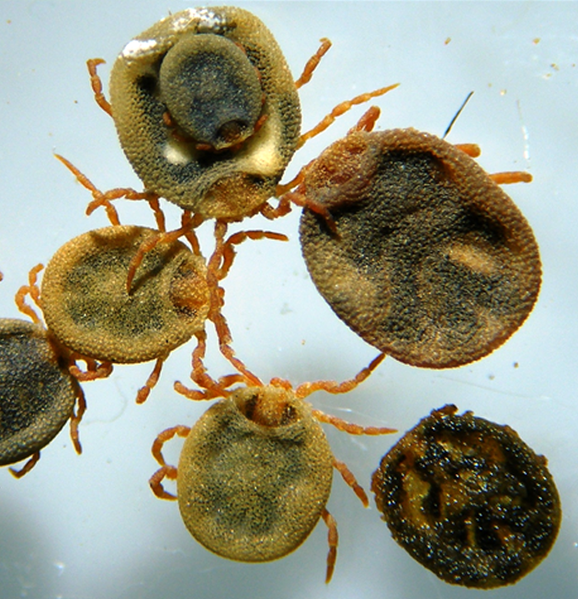
There is, interestingly enough, exactly one known tick that falls into neither of the other two groups, Nuttalliella namaqua, and it has a pretty interesting story. It shares characteristics of both the hard and soft ticks because its genus just so happens to be their common ancestor, and this original-flavor tick can adapt to almost any kind of terrestrial, vertebrate host; mammal, bird or nonavian reptile. Fossil evidence dates these ticks at least back to the Permian over 200,000,000 years ago, adapting to new hosts through every extinction event.
Still, these ancient parasites remain poorly studied and seldom encountered outside parts of South Africa. To date, only around fifty specimens have ever even been collected.
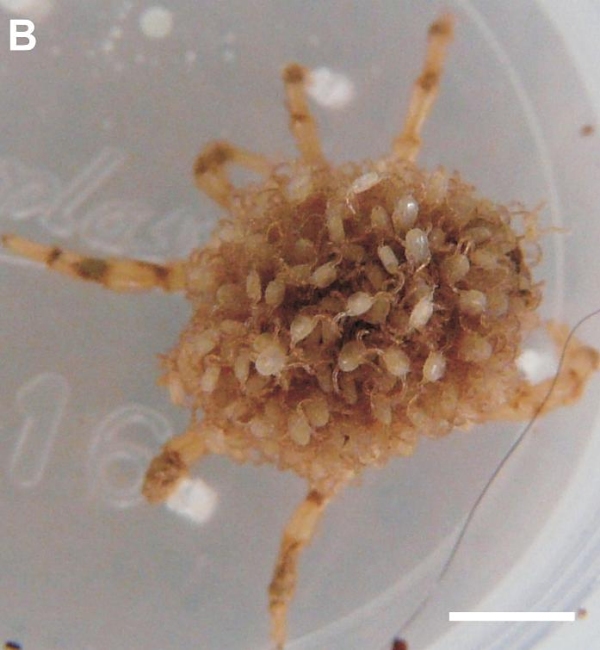
Back to soft ticks, a few species - or at least the species Antricola marginatus - adorably exhibit maternal instincts rare among their kind, though not unusual for other arachnids. Mama feeds on bat feces rather than body fluids, but the brood she carries on her back still requires fresh blood to survive and grow. As she chows down on steamy guano, her babies likely clamber down her legs, enjoy a bite of bat and quickly pile back on, sticking close to mother until they're just too big to be lugged around anymore.
Few things in this world can be cuter, obviously, than a shit eating cave monster with vampire babies, but still not quite as cute as a startling revelation made in the early research of this very article...
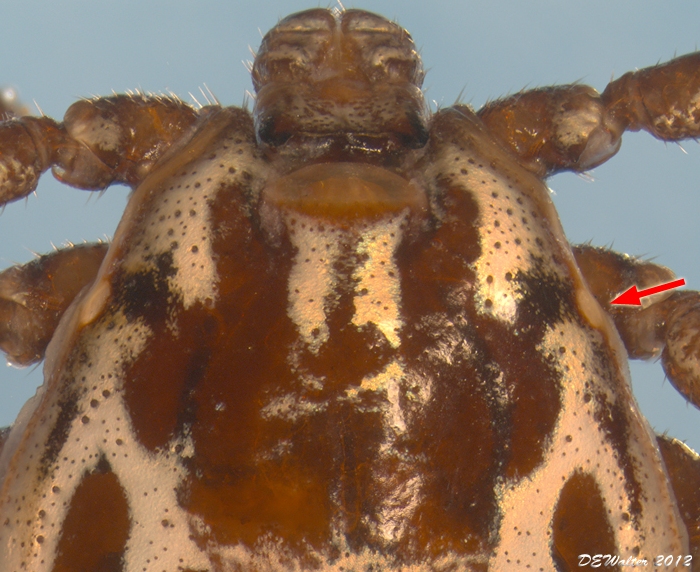
While Haller's organs are more than enough for some ticks to find their way, many hard ticks boast another sensory adaptation which positively shatters my perception of life as we know it. I was almost thirty when I wrote this entry. I've been cautiously fascinated by these animals my entire life. Until an internet search on February 14, 2013, I had no freaking idea that they ever had eyes.
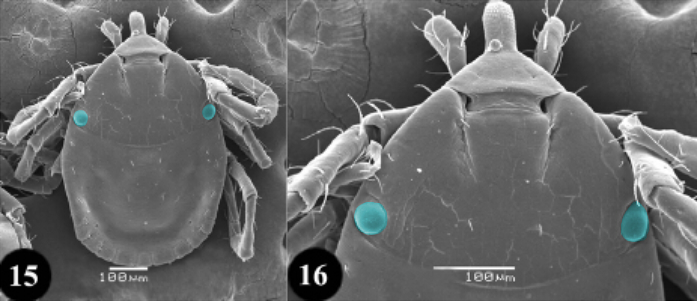
Not just any eyes, but a positively precious, perfect pair of peepers, sophisticated enough to see motion and color, situated high on what my mind always catalogued as the "body" even knowing that in mites, the head and body are part of a single large, fused segment. For twenty nine long years I was led to believe even by the fattest of biology texts that ticks were fundamentally blind animals, and that the swiveling capsule bearing their mouth parts constituted a "head."

But no, my friends, it is the tick itself that is its own head. It is one big, dopey, saucer-shaped martian face with legs. It's like the back of Kabuto, or how a three year old draws a spider. A discarded, bloodsucking tribal mask with a hacksaw. I cannot stress enough how hard this rocked the foundations of my world. Imagine you had spent your whole life looking at cats backwards - that you thought their head was only an elaborate ass until someone flipped one around for you. The vases are faces, people. I'm sorry I'm typing steadily less intelligibly. Ticks having eyes is just really really exciting for me. It's like a brand new, whimsical little animal I never truly knew. It opens up whole new realms. Whole new realms of human/tick understanding.
Just think... should you ever find one of these roly-poly gluttons sipping daintily off your bloodstream, you now know that as you pull her apart just to get her out of you and burn her to death, she's watching. Watching, and wondering what she did to incite the tasty foodmountain's seemingly senseless wrath. You're full of that stuff...can't you just spare a drop? She's wittle.

